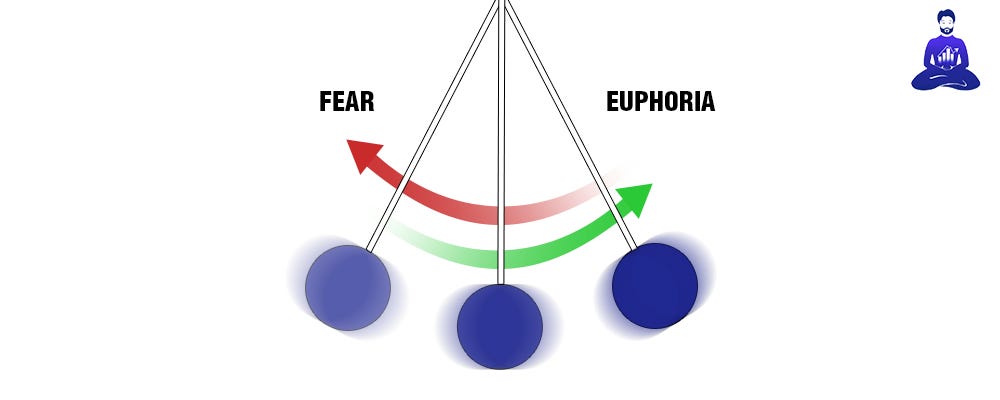Part 1: Passive Portfolio Management
Market Meditations | June 1, 2021

We’ve all felt the strain of active trading this week. From watching long red candles to liquidations, active trading can be stressful to say the least. At the same time, there is a wealth of literature that advocates passive income strategies. Their voice is dulled out during a parabolic bull market but in times like this, it’s worth taking another look and considering all our options when it comes to building wealth.
This will be a 2 part series. Today, we will make the case for passive investment strategies using A Random Walk Down Wall Street; one of the most controversial finance books. We will present the argument by drawing on statistics, psychology and history. Please note we are summarising the book and the opinions do not necessarily reflect our own. Our job is to share a wealth of literature in the realm of financial education.
Reason 1: Limitations of Fundamental Analysis
There’s two primary ways to beat the market: fundamental and technical analysis. Fundamental analysis is based on the ‘Firm Foundation Theory’; the idea that the price of an investment is anchored in something called ‘intrinsic value’. Consider intrinsic value the ‘true’ value of an asset and that the market price of an asset typically over or underestimates the value. The role of the fundamental analyst then becomes to buy assets that have an intrinsic value higher than the current price of the asset and to sell if the opposite is true.
In stock markets, calculating intrinsic value involves an assessment of: earnings growth rate, expected dividend payout, degree of risk and future market interest rates. The calculation is not so black and white. Rather, there are many problems with calculating intrinsic value: faulty information, errors and wrong conclusions in the analysis, and the influence of unexpected events.
Reason 2: Limitations of Technical Analysis
Technical analysis relies on the ‘Castle-In-The-Air-Theory’. For technical analysts, intrinsic value is of less importance. Instead, what’s most important is the behaviour of the community. Crowds do not act rationally, and they are susceptible to building castles in the air in the hopes of acquiring wealth. The role of a technical analyst then becomes to estimate which investments are most prone to castle building. A fool is born every minute, and the task of the technical analyst becomes to buy assets that later can be sold to these people. For if someone else is willing to buy higher, the price you pay doesn’t matter.
To take a hypothetical example, imagine a competition where you have to predict what the most beautiful flower in town is. The person whose selection is most like that of the crowd, wins. An intelligent investor would realise that personal opinion doesn’t matter. The best strategy is to try to anticipate what the competitors will answer. Technical analysis is no different. To take real examples, Dutch tulip bulbs during the mid-1600s, conglomerates in the late 1960s and internet stocks in the early 2000s are great examples of castles in the air. The technical analyst will use charts of stock prices and trading volume to determine future prospects of castle building.
Technical analysis is thought to work because: price increases are self-perpetuating (demand increases with every price increase which causes price to go even higher), there is unequal access to information and investors underreact to new information.
Problems with technical analysis: sharp reversals (when an uptrend is signalled, it may already be too late), profit maximisation and the techniques are self defeating (once people know about the techniques that are supposed to be effective, technicians will compete each other out: other traders will try to anticipate certain signals that they know that everyone else is buying or selling to).
Reason 3: Human Psychology Makes It Even More Difficult To Outperform the Market
Overconfidence – this bias makes us overly optimistic about assessments of the future and our own abilities. Thereby we make worse analyses and take on higher risks.
Biased Judgements – technical analysts are particularly susceptible to thinking they can completely predict future prices by purely looking at past ones.
Herd Mentality – we find it hard, if not impossible, to stand idle on the sidelines. Individuals can influence each other into thinking that an incorrect point of view is in fact the right one.
Loss aversion – losses are far more undesirable than equivalent gains are desirable. Meaning many people do the opposite of cutting losses and letting winners run. They cut their winners and let their losers run.
Solution: How To Beat Wall Street & The Random Walk
If fundamental and technical analysis makes it difficult to predict the markets and the playing field is further complicated by human psychology, what is the solution?
The solution on how to beat Wall Street according to the author: Invest for the long run, and passively primarily. There are other asset classes to consider as well, to increase diversification and decrease your risk. We will share these in Part 2 of this series on Thursday.


